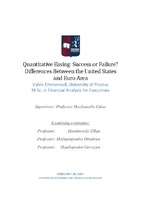Quantitative easing : success or failure? Differences between the United States and Euro Area

Master Thesis
Συγγραφέας
Βάλβης, Εμμανουήλ
Valvis, Emmanouil
Ημερομηνία
2017-02Επιβλέπων
Χαρδούβελης, ΓκίκαςΠροβολή/
Λέξεις κλειδιά
QE ; Monetary policy ; Bank lending channel ; United States ; Euro Area ; THE FED ; ECBΠερίληψη
Based on the research of (Bowman, et al., 2011) regarding the effectiveness of Japanese QE, this thesis aims to evaluate the effectiveness of QE programs in the US and Euro Area regarding lending growth. In order to do so, commercial banks from the US and Euro Area have been analyzed. Using panel regressions on banks’ balance sheet data, results identified that only the third round of the QE (2012-2014) in the United States had a significant effect on lending growth, while the first two QEs in US (2009-2011) mainly used to ease the distress in the banking sector. In the Euro Area, the recently (2015) implemented QE program did not have any significant effect on lending growth. However, results provide evidence that in both areas, banks used that extra liquidity mostly to reduce their interbank borrowings. Moreover, in US, the main driver of lending growth other than the obvious customer deposits, was the ratio of nonperforming loans. While, in Europe, EA banks’ recapitalizations in 2013, allowed them to fire sale their NPLs reducing thus their ratio.


